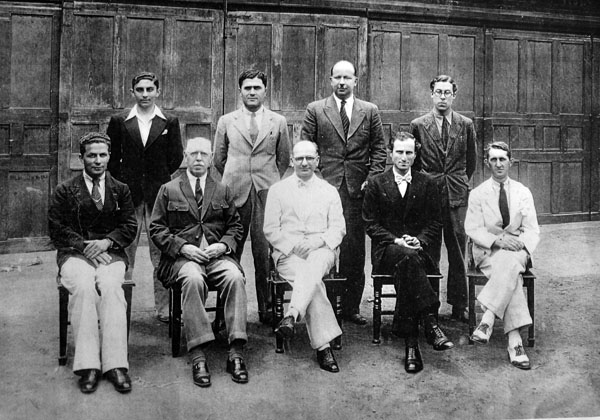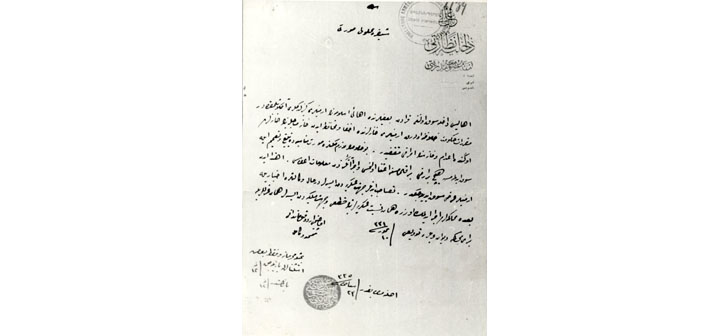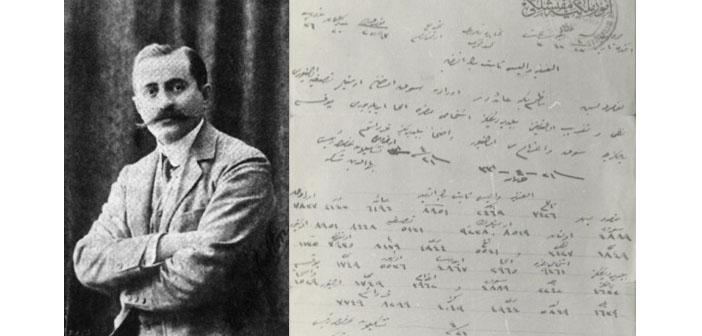In a letter to his brother Krikor,[2] who had arrived in Boston in 1914, Rev. Asadoor Z. Yeghoyan wrote from Kharpert, “Krikor you traveled all around the world, now you know by experience that the world is round, take care so you will not fall off it.”[3] The reverend’s words were not true, yet they were prophetic. At that point, Krikor had not traveled around the world—he had left the Ottoman Empire and crossed the Atlantic for the United States. However, Krikor returned to his home town shortly thereafter and was caught in the maelstrom of World War I. He survived the Armenian Genocide with the help of Kurds from Dersim and eventually arrived in the Caucasus. Yet conflict in the region kept pushing him eastward, until he reached China. In 1919, he finally arrived in the U.S. via Japan, with help from Diana Apkar, the honorary consul in Japan of the first Republic of Armenia. At that point, he had indeed traveled around the world. In this article, I present a brief history of the several thousand Armenians who, like Krikor, escaped the genocide and found safe haven in China.
Armenians in China (1880s-1950s)
Hundreds of Armenians, primarily from Russia, journeyed eastward to China in the late 19th century in search of opportunity, anchoring themselves in major cities, as well as in Harbin, a town that rose to prominence with the construction of the Chinese Eastern Railway.
Initially, Armenian railroad workers and merchants formed the core of the community in Harbin. Their numbers were small—no more than a few dozen. A larger number of Armenians lived in Manzhouli (Manchuli), which had risen to prominence in the early 20th century also thanks to railway projects. A group photograph of the Armenian community in Manzhouli (circa 1919) depicting around 150 men, women, and children, complete with the Armenian tricolor, stands as testament to the size of the Armenian community in the city.
.jpg)
A few thousand Armenians, including Yeghoyan, arrived in the region escaping genocide in Ottoman Turkey and turmoil in the Caucasus. Often, those who followed this path hoped to get to the United States. American missionary Ernest Yarrow encountered some 200 Armenian refugees in Vladivostok in late 1918, most of whom “have friends in America and are hoping in some way or other to get there.”[4] Yet most stayed in East Asia for years, even decades, helping build communities that thrived, despite conflicts, war, and foreign occupation.
Many of these Armenians coupled their personal success with a dedication to community life, helping develop small but vibrant communities. Despite conflicts, war, and foreign occupation that beset the history of China in the first half of the 20th century, Armenians built a church (Harbin), community centers (Harbin and Shanghai), and established relief organizations, choirs, and women’s groups. In the years following the 1949 Chinese revolution, Armenians fled the country (like most Christians in China) mainly in two directions: Soviet Armenia and the Americas.[5]
Garabed Meltickian was a survivor of the genocide who joined the stream of Armenian refugees traversing the Caucasus and Siberia all the way to China. Originally from Maden, Diyarbakir, Meltickian was conscripted into the Ottoman military in 1914 and dispatched to Erzincan. In 1915, he was among 120 Armenian soldiers who were handcuffed and taken away to be killed. He miraculously survived the carnage, was given shelter by Kurds, saved by advancing Russian troops, fought with Armenian forces in Kars, and after their withdrawal from the city, went to Tiflis, from there to Siberia, and finally arrived in Manchuria.[6]
“My father arrived in Manchuli exhausted, and ended up in a hospital. When Armenian Garmir Khach (Red Cross) ladies—even there we had a women’s organization—heard there was an Armenian guy at the hospital, they went to visit,” Garabed Meltickian’s daughter, Virginia, said during an interview I conducted with her in Fresno, California, in 2016. Among the women were Varsenik Psakian. The Psakians would become lifelong family friends of the Meltickians in China and then in the U.S.
In Manchuli in the late 1920s, Garabed was introduced to, and within three months married, Mariam Azatyan, originally from Karakilisa (Vanadzor). The couple’s first two children died at a very young age. “And then I showed up, unexpectedly. To the disappointment of my father, I was not a boy,” said Virginia.
The Meltickians soon moved to Harbin, where they started a business. Virginia remembered, “My father opened a grocery store and until he passed away we were running that business. Mom and dad worked there.” Alongside running his business, Garabed played an active role in the Armenian community’s life. He helped form a youth group and started a small Armenian library, arranging for the shipment of books from Hairenik publishing house in Boston, Mass.[7] He died in 1938. He was 42. “My mom could not run the business by herself, so she had to sell it. These were hard times, but we survived. Which Armenian doesn’t?” said Virginia.
Soon, the first generation of Armenians born in the city started successful businesses in China. A son of Genocide survivors, Yervand Markarian was born in Harbin, where his father had settled after the war. The family moved to Tientsin, China, in 1925.[8] Years later, reflecting upon his life’s trajectory, Markarian wrote:
I was a man born outside my ethnic fatherland which by the time of my birth had ceased to exist… As incongruous as it may seem, I was born in China, without having a drop of Chinese blood, where I later volunteered to serve in the French army but was not French, and ended up in the French Foreign Legion in Indochina (Vietnam), under rather strange circumstances. As a family man, I owned and managed restaurants in China, Brazil, and California—all of them Russian/Armenian and all of them called Kavkaz.[9]

The influx of Armenians to China continued into the 1920s—and not all were refugees. Hagop Harry Shabas, for example, was born in Pera, Istanbul, in 1895. He went to Tientsin, China, in 1925 to work for his brother-in-law, Arshak Karageusian, who ran a hugely successful rug production company, A. & M. Karagheusian, Inc.,[10] that employed a few thousand people in the United States and China, including a few dozen Armenians.[11] Hagop Shabas served as a manager for the company in Tientsin, and even authored a book on rugs, titled The Chinese Carpet Industry. In 1928, he married a fellow Istanbul Armenian, Alice Artinian (born in 1906). They had two daughters, Sonig Marie (1929) and Elise (1935).
Newspapers in China and the Genocide
Many in China were not oblivious to the fate of Ottoman Armenians as hundreds of survivors arrived in Harbin and other cities. Russian, English, Chinese, and Japanese language newspapers reported on the fate of the Ottoman Armenians.
The North China Herald (published in Shanghai beginning in 1850), for example, ran dozens of reports on the Hamidian massacres, the Adana massacres, the Armenian Genocide, relief efforts to assist Armenian deportees and refugees in the Caucasus and in Syria, peace treaties and negotiation processes involving Armenian representatives, and the Armenian communities in Harbin and Shanghai as they established a church and a community center. A report titled “Massacres in Armenia. Horrible Atrocities” (4 December 1915), provided details furnished by Viscount Bryce about massacres in Bitlis and Mush and drownings in the River Tigris. Another article, “Awful Massacres in Armenia. Wholesale Drowning at Trebizond” (16 October 1915) noted that in the House of Lords, Earl Cromer said Germany’s “moral responsibility [in Armenian massacres] was unquestionable.” The author called for “utmost publicity” in India and Egypt expressing belief that educated Muslims there would be equally outraged by the atrocities. The author went on to argue that the only way to rescue the survivors would be “an expression of opinion from the World, especially from neutrals.”

Interactions with missionaries
The role of missionaries in providing relief and assistance to Armenians during and in the aftermath of the genocide is well-documented, with focus on humanitarian work in the Ottoman Empire and the Caucasus. Yet missionaries assisted Armenians, including deportees who had escaped the genocide, also in faraway cities like Vladivostok and Harbin. One such missionary was Rev. Ernest A. Yarrow, who spent almost a year in Siberia and Manchuria beginning in late 1918, following a decade of service in Van (September 1904-October 1915) and the Caucasus (1916-1919), before another five years in the Caucasus with Near East Relief (1920-1925).
Working for the Red Cross in Vladivostok, Yarrow helped house refugees “among whom were about 200 Armenians who had come from the Caucasus, some of whom I knew personally.”[12] Now in East Asia, Yarrow once again embarked upon helping Armenians from the Ottoman Empire and the Caucasus. “Among those whom I knew were Aghavnee and Marina, who were teachers in our school [in Van] and whom I put in charge of the stores until they got permission to leave. I got them good outfits of clothing and left them quite happy,” he wrote.[13]
Yarrow employed several Armenians, and secured jobs for many others. Armenian refugees in Siberia and Manchuria remembered Yarrow fondly for his efforts. In his memoir, Krikor Yeghoyan wrote:
[W]e visited Vladivostok [from Harbin]…. The first wagon rolling in was the one with the Armenians. At this instant we noticed one gentleman and two nurses. The nurses came over; they asked us, “Are you Armenians?” in Armenian. We answered, “Yes.” Right away they asked us if there were any tradesmen amongst us. I said I was a carpenter. The man said, “Good.” He left the nurses here and brought me to a town to meet the General. On our way, I asked him how come he knew such good Armenian. He said he was a missionary in Van. He learned it there and his name was Yarrow. I became very interested in the man. I asked him this time if he ever went to Harpoot. “Yes, but only for conventions.” In that case I suppose you must know Rev. Yeghoyan [Krikor’s brother]. “Oh, yes,” he said, he was a powerful minister. I continued saying, I was his brother, that I was in America one time, and doing carpentering there. “Do you speak English?” “Yes, a little,” I said. “Oh, you are just the man we are looking for!” At last I met the General; Yarrow introduced me to him giving all the details of my life and adding that I had been in U.S.A. After this formal conversation, I was appointed as supervisor over all the refugees, and master carpenter with a salary of 400 rubles, also board and lodging.[14]
Not all refugees Yarrow helped in Vladivostok anchored themselves in Siberia and China. Arriving in Egypt in March 1919, Yarrow met with several of the Armenians he had helped in Vladivostok months earlier. They were at the Armenian refugee camp in Port Said that was comprised of several thousand Armenians rescued from Musa Dagh by a French battleship, and a few thousand Armenians from elsewhere. “You remember my writing from Siberia that I had housed and organized the support of about 200 Armenians in Vladivostok?” Yarrow asked in a letter to his friend. “I was amazed to find that 35 of these had reached Port Said and were in the camp. They had been sent by boat by the Red Cross to make their way back to Armenia!”[15]
The community scatters
For several decades, hundreds of genocide survivors called China home, helping build communities that celebrated Armenian heritage and culture across the globe from the homeland. World War II and the 1949 Chinese revolution displaced these Armenians once again, scattering them across the globe—to Soviet Armenia, North America, and Australia. Krikor Yeghoyan ended up in Fresno, California. The Meltickian family fled to Paraguay, and eventually settled in Fresno. Yervand Markarian moved to Brazil, then to Los Angeles, California. The Schabas family made San Francisco their home.
Despite the difficulties they faced in China, Armenians generally have fond memories of their time in East Asia. I interviewed Hagop Scabas’s daughter, Elise Kazanjian, in San Francisco in 2015. “We would go to Beijing on vacation. We would go the [Great] Wall. We would go sit on the stones from the wall, and I swear I could feel history there. I’d close my eyes and my father would say, ‘What are you doing?’ I could visualize the guards who lived there, and died here and were buried in these walls and never got to leave, and the skirmishes they would have,”[16] Kazanjian said.
She continued, “My memories of China are based on the senses. I like the Chinese opera, always have; I love the Chinese discordant music; I like tactile things that were part of my life. China also means my amah [nanny], who was a second mother to me. She had bound feet. China also means bound feet to me in more ways that just binding of the feet.
*A shorter version of this article appeared in the Armenian Weekly April 2016 Magazine. This article is part of a much more detailed research report on the history of the Armenian communities in China in the 19th and 20th centuries, which will be published in an edited volume. I would like to thank the Gulbenkian Foundation for granting me a research fellowship that made this work possible.
[2] Krikor Z. Yeghoyan’s unpublished memoir, The Story of My Life, was written in 1952. Victoria Dadekian prepared a condensed English translation in 1970, which I cite in this report. I would like to thank Mimi Malayan for bringing the memoir to my attention. It is available at: http://issuu.com/dianaapcar.org/docs/memoir__the_story_of_my_life__by_krikor_z._yeghoya/1.
[3] Yeghoyan, The Story of My Life, 4.
[4] Letter from Yarrow to Rev. Dr. Earle H. Ballou (20 November 1918). ABC 16.9.7, vol. 25d, item 260 (Papers of the ABCFM, reel 717). Dr. Ballou worked for ABCFM in China from 1917 until WWII.
[5] A few families, for example, settled in Australia.
[6] H. Bsag (Hamazasp Psakian), “Garabed Mldigian,” Asbarez Daily, 12 April 1963.
[7] Ibid. Meltickian passed away in 1937. His wife and daughter eventually settled in Fresno, Calif. The Meltickian Collection referenced in this article is donated to the University of Fresno’s Armenian Studies Program by his daughter, Virginia Meltickian.
[8] Yervand Markarian, Kavkaz: A Biography of Yervand Markarian (United States: 1996), 7.
[9] Ibid., 2.
[10] Arshag and Mi(h)ran Karagheusian came from a family of makers and merchants of rugs in the Ottoman Empire. They moved to Great Britain and soon thereafter to the United States following the Hamidian massacres, and started a business of importing and within a few years, manufacturing rugs.
[11] An entire town in New Jersey has thrived thanks to the company. See, for example, Karen Demasters, “A Factory That Wove Rugs and Bound a Town Together,” The New York Times, 9 April 2000. Available online at: http://www.nytimes.com/2000/04/09/nyregion/on-the-map-a-factory-that-wove-rugs-and-bound-a-town-together.html, accessed 20 October 2015.
[12] Letter from Yarrow to Rev. Dr. Earle H. Ballou (20 November 1918). ABC 16.9.7, vol. 25d, item 260 (Papers of the ABCFM, reel 717). Dr. Ballou worked for ABCFM in China from 1917 until WWII.
[13] Ibid.
[14] Krikor Z. Yeghoyan, The Story of My Life, 28.
[15] Letter from Yarrow to Rev. Dr. Earle H. Ballou (14 March 1919). ABC 16.9.7, vol. 25d, item 264 (Papers of the ABCFM, reel 717).
[16] Ibid.





